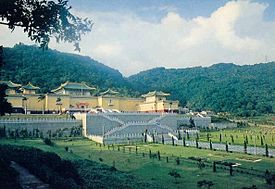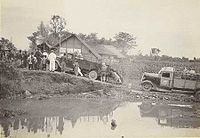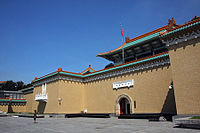- National Palace Museum
-
National Palace Museum
國立故宮博物院
The National Palace Museum in 1970Established October 10, 1925 in Beijing
November 12, 1965 in TaipeiLocation Taipei,  Republic of China
Republic of ChinaVisitor figures 3,441,238 (2010)[1] Director Chou Kung-Hsin (周功鑫) Curator Feng Ming Chu (馮明珠)
Huang Yung-TaiWebsite www.npm.gov.tw The National Palace Museum is an art museum in Taipei. It is the national museum of the Republic of China, and has a permanent collection of over 677,687 pieces of ancient Chinese artifacts and artworks, making it one of the largest in the world.[2] The collection encompasses over 8,000 years of Chinese history from the Neolithic age to the late Qing Dynasty.[3] Most of the collection are high quality pieces collected by China's ancient emperors.
The National Palace Museum and Palace Museum, located inside the Forbidden City in China, share the same original roots, which was split in two as a result of the Chinese Civil War.[4]
Contents
History
The National Palace Museum was originally established as the Palace Museum in Beijing's Forbidden City on 10 October 1925, shortly after the expulsion of Puyi,[5] the last emperor of China, from the Forbidden City by warlord Feng Yü-hsiang. The articles in the museum consisted of the valuables of the former Imperial family.[6]
In 1931, shortly after the Mukden Incident Generalissimo Chiang Kai-shek's Nationalist Government ordered the museum to quickly move its most valuable pieces out of the city to prevent them from falling into the hands of the Imperial Japanese Army. Select pieces from the Palace Museum and the Preparatory Office of the Central Museum were selected for removal, as well as rare books of the Central Library and artefacts of the Institute of History and Philology at Academia Sinica.[6] As a result, on 6 February 1933, 13,491 boxes were moved in two trains from the plaza in front of the Gate of Divine Might to the North.[citation needed] The collection was moved to several places, including Shanghai, Anshun, Yibin as the Imperial Japanese Army advanced farther inland during the Second Sino-Japanese War, which merged into the greater conflict of World War II. The Chinese Civil War resumed following the surrender of the Japanese ultimately resulting in Generalissimo Chiang Kai-shek's decision in evacuating the art to Taiwan.[7]
When the fighting worsened in 1948 between the Communist and Nationalist armies, the Directors of the Palace Museum made the decision to send some of the most prized items in the Museum's collection to Taiwan. Hang Li-wu, later director of the museum, supervised the transport of some of the collection in three parts over four days to the harbor in Keelung, Taiwan aboard the freighter Chung Ting during the February of 1948. A total of 2,972 crates were shipped in three groups and arrived in Keelung in February 1948. By the time the items arrived in Taiwan, the Communist army had already seized control of the Palace Museum collection so not all of the collection could be sent to Taiwan. The 2,972 crates of artifacts moved to Taiwan only accounted for a quarter of the items originally transported South from Beijing, although the pieces represented some of the very best of the collection.
The collection in Keelung was stored in a railway warehouse following transport across the Taiwan Strait and was later moved to a sugar cane factory near Taichung. In 1948, the Executive Yuan created the Joint Managerial Office of the Palace Museum, the Preparatory Office of the Central Museum, and the Central library to oversee the organization of the collection in Wufeng, Taichung.[6] The collection was then moved to the new museum in Wai-shuang-hsi upon its completion in 1965.[3][6] During the 1960s and 1970s, the National Palace Museum was used by the Kuomintang to support its claim that the Republic of China was the sole legitimate government of all of China, in that it was the sole preserver of traditional Chinese culture amid social change and the Cultural Revolution in mainland China, and tended to emphasize Chinese nationalism.
In English, the institution in Taipei is distinguished from the one in Beijing by the additional "National" designation. In common usage in Chinese, the institution in Taipei is known as the "Taipei Gugong" (臺北故宮), while that in Beijing is known as the "Beijing Gugong" (北京故宮).
The PRC government has long said that the collection was stolen and that it legitimately belongs in China, but Taiwan has defended its collection as a necessary act to protect the pieces from destruction, especially during the Cultural Revolution. However, relations regarding this treasure have warmed in recent years and the Palace Museum in Beijing has agreed to lend relics to the National Palace Museum for exhibitions[8] and Palace Museum curator Zheng Xinmiao have said that the artifacts in both mainland and Taiwan museums are "China's cultural heritage jointly owned by people across the Taiwan Strait."[9]
A number of Chinese artifacts dating from the Tang Dynasty and Song Dynasty, some of which had been owned by Emperor Zhenzong, were excavated and then came into the hands of the Kuomintang General Ma Hongkui, who refused to publicize the findings. Among the artifacts were a white marble tablet from the Tang Dynasty, gold nails, and bands made out of metal. It was not until after Ma passed away that his wife went to Taiwan in 1971 from America to bring the artifacts to Chiang Kai-shek, who turned them over to the National Palace Museum.[10]
The Museum building
The National Palace Museum building in Taipei was designed by Huang Baoyu (黃寶瑜) and constructed from March 1964 to August 1965. Due to the insufficient space to put on display over 677,687[11] artifacts, the museum underwent renovations in 1967, 1970, and 1996. In 2001, the museum underwent a major $21-million-dollar renovation revamping the museum to make it more spacious and modern.[12] It was accelerated in 2002, during which about two-thirds of the museum section was closed. The museum reopened on Christmas Day 2006, after a long ten-year renovation.
The displays are rotated once every three months, which means 60,000 pieces can be viewed in a year and it would take nearly 12 years to see them all.[13]
Art collections
The National Palace Museum main artifacts categories are:
Today the museum is said to house some 93,000 items of Chinese calligraphy, porcelain, bronzes, landscape paintings, portraiture and figurines from Beijing's Forbidden City and 562,000 traditional books and documents. There are 6,044 bronzes, 5,200 paintings, 3,000 works of calligraphy, 12,104 pieces of jade, 3,200 examples of lacquer and enamel ware, as well as assorted carvings, fans, rubbings, coins and textiles.[14]
With a collection of this size, only 1% of the collection is exhibited at a given time. The rest of the collection is stored in temperature controlled basement vaults.[12]
Notable items
The museum houses several treasured items that are the pride of their collection and famous worldwide. They include:
- The "Jadeite Cabbage": A piece of jadeite carved into the shape of a cabbage head, and with a large and a small grasshopper camouflaged in the leaves. The ruffled semi-translucent leaves attached is due to the masterful combination of various natural colour of the jade to recreate the color variations of a real cabbage.[15]
- The "Meat-shaped Stone":[16] A piece of jasper, a form of agate, the strata of which are cleverly used to create a likeness of a piece of pork cooked in soy sauce.[17] The dyed and textured surface makes the layers of skin, lean meat, and fat materialized incredibly lifelike.
- The "Palace version" of the Along the River During the Qingming Festival: Even though this is only a copy (the original is in the Palace Museum, Beijing), it is nevertheless regarded as an artistic masterpiece.
- The "Carved Olive-stone Boat":[18] A tiny boat carved from an olive stone. The incredibly fully equipped skilled piece is carved with a covered deck and moveable windows. The interior has chairs, dishes on a table and eight figures representing the characters of Su Shih's "Latter Ode on the Red Cliff." The bottom is carved in minute character the entire 300+ character text with the date and the artist's name.
- The "One Hundred Horses": A painting done in 1728 by Giuseppe Castiglione by implementing a mixture of western artistic skills and utilizing eastern materials to realize a sense of realism to this native theme.[19]
- Jiu Manzhou Dang: a set of Manchu archives that are the sourcebook of Manwen Laodang and a primary source of early Manchu history.
Overseas Exhibitions
- 1935: "London International Exhibition of Chinese Art" at the British Museum London.
- 1940: "Chinese Art Exhibition" in Moscow, Leningrad.
- 1961: "Ancient Chinese Art Exhibition" National Gallery of Art in Washington DC, New York Metropolitan Museum of Art, Boston Museum of Fine Arts, Museum of Contemporary Art, Chicago, the Asian Art Museum of San Francisco.
- 1973: "China Exhibition" in Seoul, South Korea.
- 1991: "On the Occasion of 1492: the art of the Age of Exploration" at the Washington National Gallery of Art.
- 1996: "Splendors of Imperial China" at the Metropolitan Museum of Art, Museum of Contemporary Art, Chicago, Asian Art Museum of San Francisco, Washington, DC National Gallery of Art exhibition.
- 1998: "Empire of Memory" at the Grand Palais in Paris exhibition.
- 1999: National Palace Museum exhibition in Central America.
- 2000: "Taoism and Chinese art," Museum of Contemporary Art, Chicago and Asian Art Museum of San Francisco.
- 2003: "Treasures of the Son of Heaven," the old museum in Berlin, Bonn, Federal Art Gallery touring exhibition.
- 2005: "Museum of World Culture Expo Korea" in Korea.
- 2005: "The Mongolian Empire - Genghis Khan and his generation" exhibition at the Museum of Anthropology in Munich, Germany.
- 2006: "magnificent years of the Qing court (1662-1795)" exhibition at the Guimet Museum, France.
- 2007: "Shanghai - Modern Art" exhibition in Japan.
- 2008: "Imperial Treasures" in the Kunsthistorisches Museum Vienna exhibition.
Zhishan Garden
Housed within the compound of the National Palace Museum, this classical Chinese Song and Ming style garden covers 1.88 hectares (18,800 m3) and incorporates the principles of such diverse fields as feng shui, Chinese architecture, water management, landscape design, and Chinese folklore and metaphor. It contains numerous ponds, waterworks, and wooden Chinese pavilions. It was completed and opened in 1985.[20] There is also another Chinese Style Garden nearby called the Shuangxi Park and Chinese Garden.
Chang Dai-chien Residence
The National Palace Museum also maintains the residence of renowned Chinese painter Chang Dai-chien. The residence is known as the Chang Dai-chien House or Abode of Maya and was constructed in 1976. After his death, the house and gardens were donated to the National Palace Museum and turned into a museum and memorial.
Southern Branch
The National Palace Southern Branch will be located in Taibao, Chiayi County, Taiwan and set on 70 hectares (700,000 m3) of land. Besides the museum, there will be a lake and Asian style garden. The Southern Branch of the National Palace Museum is an institution conceived for the promotion of Asian arts and culture. The building was to be designed by architect Antoine Predock and began construction in 2005. However due to serious construction delays and disputes between the contractors and the museum, the firm pulled out in 2008.[21] Museum director Chou Kung-shin stated in August 2010 that new architects for the project would commence, with construction expected to be completed in 2015.[22] The project is expected to cost NT$7.9 billion (US$268 million) and spread over 70 hectares (700,000 m3).[23] It will be designed by the Taiwan-based firm Artech Inc. and will be both earthquake resistant and flood resistant.[23]
Gallery
-
Chinese guardian lions in front of the Museum.
-
The Jadeite Cabbage
-
A Ming Dynasty statue of Buddhist deity, Guanyin.
Footnotes
- ^ "National Palace Museum Annual Report 2010". National Palace Museum. April 2011. p. 59. http://www.npm.gov.tw/UserFiles/File/zh-tw/335000000E-I52-149.pdf. Retrieved 2011-05-30.
- ^ "Categories in the Collection". National Palace Museum official website. 4 May 2009. http://www.npm.gov.tw/en/administration/about/objects.htm#02. Retrieved 2009-09-26.
- ^ a b http://www.chinapost.com.tw/taiwan/arts-&-leisure/2009/05/12/207758/p2/National-art.htm
- ^ "Taipei's National Palace Museum". BBC. http://www.bbc.co.uk/worldservice/programmes/newshour/news/story/2007/02/070208_taipei_museum.shtml. Retrieved 2008-06-04.
- ^ "National Palace Museum Chronology of Events 1921-1931". National Palace Museum. http://www.npm.gov.tw/en/administration/about/chronology.htm#01. Retrieved 2008-06-04.
- ^ a b c d "National Palace Museum Chronology of Events". National Palace Museum. http://www.npm.gov.tw/en/about/chronology.htm. Retrieved 2010-12-20.
- ^ "The National Palace Museum: Timeline of the NPM". National Palace Museum. http://www.npm.gov.tw/exh96/orientation/index3_2_en.html. Retrieved 2010-12-20.
- ^ China to lend treasures to Taiwan
- ^ http://www.aol.co.nz/celebrity/story/China-not-demanding-immediate-return-of-Taiwan-art/1745071/index.html
- ^ China archaeology and art digest, Volume 3, Issue 4. Art Text (HK) Ltd.. 2000. p. 354. http://books.google.com/books?id=0UzrAAAAMAAJ&q=in+1971,+his+widow+took+them+from+America+to+Chiang+Kai-shek+in+Taiwan.+They+were+later+acquired+by+the+National+Palace&dq=in+1971,+his+widow+took+them+from+America+to+Chiang+Kai-shek+in+Taiwan.+They+were+later+acquired+by+the+National+Palace&hl=en&ei=414OTZT6GIL_8AaO8p2ADg&sa=X&oi=book_result&ct=result&resnum=1&ved=0CCUQ6AEwAA. Retrieved 2010-11-28.
- ^ "National Palace Museum - Categories in the Collection". National Palace Museum. http://www.npm.gov.tw/en/administration/about/objects.htm#02. Retrieved 2008-06-04.
- ^ a b Gluck, Caroline (2007-02-07). "Taiwan's museum of treasures". BBC News. http://news.bbc.co.uk/2/hi/asia-pacific/6335469.stm. Retrieved 2010-03-30.
- ^ "National Palace Museum". taiwan.com.au. http://www.taiwan.com.au/Envtra/Taipei/report02.html.
- ^ http://www.chinapost.com.tw/taiwan/arts-&-leisure/2009/05/12/207758/p1/National-art.htm
- ^ "Jadeite Cabbage with Insects". National Palace Museum. http://www.npm.gov.tw/en/collection/selections_02.htm?docno=867&catno=16&pageno=2. Retrieved 2008-06-04.
- ^ "Meat-shaped Stone". National Palace Museum. http://www.npm.gov.tw/en/collection/selections_02.htm?docno=900&catno=12&pageno=2. Retrieved 2008-06-04.
- ^ "Jadeite Cabbage is Moving to a New Gallery!". National Palace Museum. http://www.npm.gov.tw/en/administration/services/news_02.htm?docno=143&pageno=4. Retrieved 2008-06-04.
- ^ "Carved Olive-stone Boat". National Palace Museum. http://www.npm.gov.tw/en/collection/selections_02.htm?docno=904&catno=12&pageno=2. Retrieved 2008-06-04.
- ^ "One Hundred Horses". National Palace Museum. http://www.npm.gov.tw/en/collection/selections_02.htm?docno=92&catno=15&pageno=5. Retrieved 2008-06-04.
- ^ http://www.npm.gov.tw/exh96/chih-shan/index3_en.html
- ^ "U.S. architectural firm quits NPM southern branch project". The China Post. 2008-11-28. http://www.chinapost.com.tw/taiwan/t-business/2008/11/28/185218/U.S.-architectural.htm. Retrieved 2010-12-20.
- ^ "National Palace Museum chief upsets lawmakers". Taipei Times. 2010-11-11. http://www.taipeitimes.com/News/taiwan/archives/2010/11/11/2003488259/1. Retrieved 2010-12-20.
- ^ a b "National Palace Museum in Taiwan unveils designs of Southern Branch". World Interior Design Network. 2011-03-28. http://www.worldinteriordesignnetwork.com/news/national_palace_museum_in_taiwan_unveils_designs_of_southern_branch_110329/. Retrieved 2011-04-09.
See also
External links
- In Pictures: NPM reopens (BBC)
- Giuseppe Castiglione & Lee Tze Fan at The National Palace Museum
- National Palace Museum official website(English)
- National Palace Museum Online (subscription)
- National Palace Museum Periodicals (subscription)
- NY Times (subscription)
- NY Times: Rare Glimpses of China’s Long-Hidden Treasures
- Taipei's National Palace Museum
- The National Palace Museum
- The Splendors of Imperial China: Treasures from the National Palace Museum, Taipei
- National Geographic: Inside - The Emperor's Treasure(1) (English with Chinese Subtitle)
- The Emperor's Treasure better quality (English with Chinese Subtitle)
- Chiang Dai-chien Memorial Hall
 Executive Yuan
Executive YuanMinistries 
Commissions Communication · Consumer Protection · Election · Financial Supervisory · Fair Trade · Mongolian and Tibetan Affairs · Overseas Compatriot Affairs · Public Construction Commission · Research, Development and Evaluation · Veterans Affairs · YouthCouncils Agriculture · Atomic Energy · Aviation Safety · Cultural Affairs · Hakka Affairs · Indigenous Peoples · Economic Planning and Development · Labor Affairs · Mainland Affairs · Science · Sports AffairsAgencies Budget, Accounting and Statistics · Coast Guard · Environmental Protection · Government Information · Health · PersonnelOther bodies Central Bank · National Palace MuseumCoordinates: 25°06′07″N 121°32′55″E / 25.10194°N 121.54861°E
Categories:- Buildings and structures completed in 1965
- Chinese culture
- Museums established in 1964
- National museums of Taiwan
- National Palace Museum
- Art museums and galleries in Taiwan
- Museums in Taipei
- Visitor attractions in Taipei
- Executive Yuan
Wikimedia Foundation. 2010.









